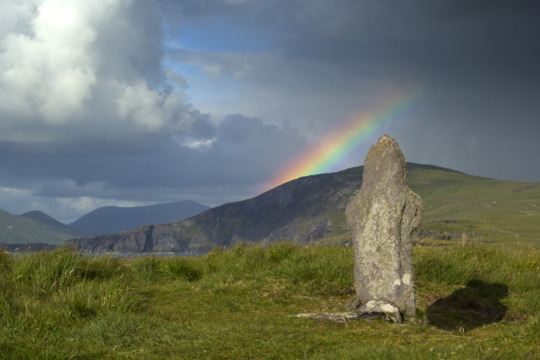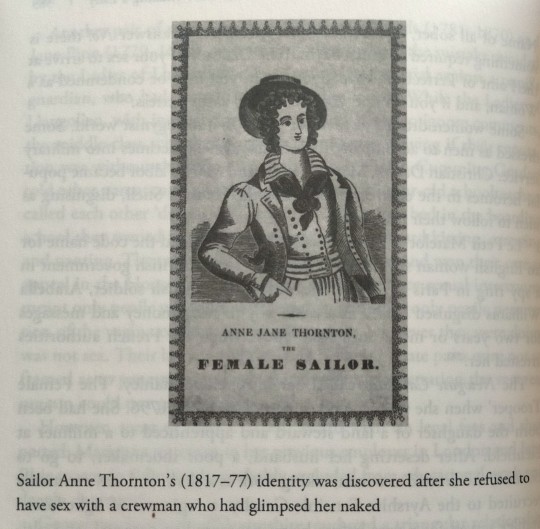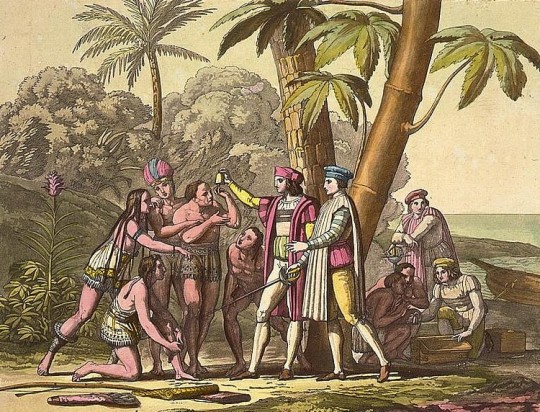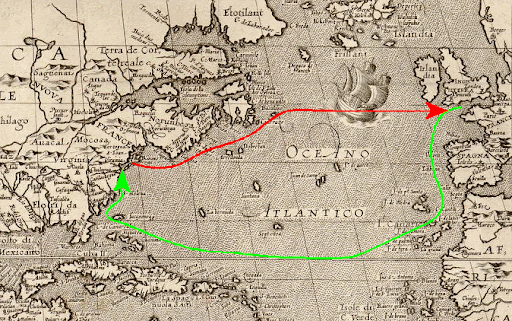#Transatlantic Voyager
Explore tagged Tumblr posts
Text
#OTD in 587 – St Brendan the Navigator, early transatlantic voyager, dies.
In 484 St. Brendan was born in Ciarraighe Luachra near the port of Tralee, in Co Kerry, in the province of Munster, in the South West of Ireland. He was baptised at Tubrid, near Ardfert, by Saint Erc. He spent his first year with his parents, then he went to the home of the local chieftain, Airde mac Fidaigh at Cathair Airde in Listrim, three miles to the East. He returned to his family at the…

View On WordPress
#Ancient Cross#Ardfert#Co. Kerry#Egressio familiae S. Brendani#Holy Well#Ireland#Mount Brandon#Naval Academy#Navigatio Brendani#Patron Saint of sailors and travellers#St Patrick#St. Brendan the Navigator#Transatlantic Voyager#Twelve Apostles of Ireland#United States Naval Academy#Valentia Island
12 notes
·
View notes
Text
Anne Jane Thornton, a 15-year-old girl, dressed as a cabin boy on a transatlantic voyage to find the man she loved, who had gone to America in 1832. On arrival, she found he had died so she took posts on other ships, calling herself Jim Thornton. On her return crossing to London on The Sarah, a crew member noticed that she was a woman and she was taken to the ship's captain, who kept her on as a crewman.

"Normal Women: 900 Years of Making History" - Philippa Gregory
#book quotes#normal women#philippa gregory#nonfiction#anne jane thornton#cabin boy#cross dressing#transatlantic voyage#america#england#london#30s#1830s#19th century#the sarah#ship's captain#crewman#sailor#jim thornton#the interesting life and wonderful adventures of that extraordinary woman anne jane thornton‚ the female sailor#autobiography
129 notes
·
View notes
Text

🇺🇲 February 14, 1924 – A pivotal day in automotive history! Walter Chrysler was officially elected president of the Maxwell Automobile Company, setting the stage for one of the most influential car brands in America.
🔧 By 1921, Maxwell was struggling, and Chrysler, a former Buick executive, saw an opportunity. He took controlling interest in the company and worked to revitalize it.
🚘 In 1925, Maxwell was phased out, and all assets were merged into a brand-new company—the Chrysler Corporation. The first Chrysler-branded car had already debuted in 1924, featuring advanced engineering for the time, like a high-compression engine and four-wheel hydraulic brakes. This bold move laid the foundation for decades of automotive innovation.
🏁 From this moment on, Chrysler would go on to challenge the biggest names in the industry, eventually growing into one of the Big Three automakers in Detroit.
Transatlantic Torque: Brits & Yanks on Wheels!
#transatlantic torque#brits and yanks on wheels#cars#old cars#retro cars#vehicle#brands#companies#automobile#american cars#chrysler voyager#chrysler cirrus#walter chrysler#daimler chrysler#chrysler#detroit#michigan#maxwell motors#sedan#american auto#big three#buick#buick regal#buick riviera#buick lesabre#merry chrysler#car brands#old car#classic cars#classic car
12 notes
·
View notes
Text
Me

#og post#CDDA#cataclysm dark days ahead#I love the background skills they really let you roleplay#If a zombie apocalypse happens my first plan of action is moving to south america cause I need my coffee#Literally redo the transatlantic voyage from scratch because I heard of the mythical land of Brazil
16 notes
·
View notes
Text
40,000 years ago, early humans painted hands on the wall of a cave. This morning, my baby cousin began finger painting. All of recorded history happened between these two paintings of human hands. The Nazca Lines and the Mona Lisa. The first TransAtlantic flight and the first voyage to the Moon. Humanity invented the wheel, the telescope, and the nuclear bomb. We eradicated wild poliovirus types 2 and 3. We discovered radio waves, dinosaurs, and the laws of thermodynamics. Freedom Riders crossed the South. Hippies burned their draft cards. Countless genocides, scientific advancements, migrations, and rebellions. More than a hundred billion humans lived and died between these two paintings—one on a sheet of paper, and one on the inside of a cave. At the dawn of time, ancient humans stretched out their hands. And this morning, a child reached back.
92K notes
·
View notes
Text
anyone being like “i’m fine with no more flying, bring back covered wagons and transatlantic voyages” is offering to pay for me to see my loved ones, right? right?
101 notes
·
View notes
Text

The SS Great Eastern, launched in 1858, was a monumental achievement in 19th-century engineering, epitomizing the era's rapid technological advancements. Designed by the visionary Isambard Kingdom Brunel and built by John Scott Russell & Co. at the Millwall Iron Works on the River Thames, she was the largest ship ever constructed at the time, symbolizing human ambition and innovation.
The Great Eastern featured a revolutionary iron hull and a unique propulsion system that combined sails, paddle wheels, and a screw propeller. Designed to carry 4,000 passengers, she was built for long-distance voyages, including non-stop travel from England to Australia. Brunel's vision was to transform global transportation, making both passenger travel and trade faster and more efficient on an unprecedented scale.
Despite facing significant financial and technical challenges, the Great Eastern achieved lasting recognition for laying the first successful transatlantic telegraph cable in 1866, a milestone that revolutionized global communication. Though her early years were fraught with difficulties, her immense size and groundbreaking design influenced future shipbuilding and engineering. The SS Great Eastern stands as a testament to human ingenuity, determination, and the relentless pursuit of progress.
#maritime history#naval history#united states navy#us navy#pogi americano#naval#age of sail#naval artifacts#american history
58 notes
·
View notes
Text
Did somebody order the DCA Titanic au?!!
Summary: In the alternative XX century the most luxurious transatlantic made by man begins her maiden voyage. Two automatons and a human meet on its board and fall in love. But this ship is destined to sink.

I'm trying to get out of slump so
Yes I started writing a fic based off the plot of Titanic from 1996 the one with Leonardo dicaprio? The first chapter is here, the second will be god knows when. Hopefully soon! Enjoy!
59 notes
·
View notes
Text
Checking for Good Omens S3 news like waiting to hear that a loved one made it safely through a dangerous transatlantic voyage.
57 notes
·
View notes
Text
Some butterflies may be able to journey across entire oceans with the help of the wind. A world-first study has now shown that the painted lady butterfly (Vanessa cardui) can cross the world's second-largest ocean, the Atlantic, covering 4,200 kilometers (2,610 miles) in as few as five to eight days. The trip, researchers claim, "is among the longest documented for individual insects, and potentially the first verified transatlantic crossing." The incredible discovery was made after more than a decade of mystery.
Continue Reading.
101 notes
·
View notes
Photo

Native American Enslavement in Colonial America
Slavery was practiced by the Native Americans before any Europeans arrived in the region. People of one tribe could be taken by another for a variety of reasons but, whatever the reason, it was understood that the enslaved had done something – staked himself in a gamble and lost or allowed himself to be captured – to warrant such treatment.
This model changed with the arrival of the Spanish in the West Indies in 1492 and their colonization of that region, South, and Central America throughout the 16th century. Native Americans were then enslaved simply for being Native Americans. In North America, after the English arrived, Native Americans were at first enslaved as prisoners of war but, eventually, were taken and sold to plantations in the West Indies to clear the land for expansion of English colonies.
This practice continued throughout the colonial era aided and encouraged by Native American tribes themselves up through 1750 and, after the American War of Independence (1775-1783), natives were pushed into the interior as African slavery became more lucrative. Even so, the enslavement of Native Americans continued even after slavery was abolished by the 13th Amendment to the Constitution in 1865. Americans got around illegal enslavement of natives by calling it by other names and justified it in the interests of "civilizing the savages". The practice continued up through 1900, dramatically impacting Native American cultures, languages, and development.
Native American Slavery & Columbus
Native American tribes were incredibly diverse, each with their own culture, and far from the cohesive, unified civilization they are often represented as under the umbrella term "Native American" or "American Indian". Each tribe understood itself as inherently superior to others and although they would form alliances for short periods in a common cause, or for longer periods as confederacies, they frequently warred with each other for goods, in the name of tribal honor, and for captives, among other reasons.
Men, women, and children taken captive were then enslaved by the victorious tribe, sometimes for life and other times for a given number of years and, in still other cases, until they were adopted and became members of the tribe. People could also be enslaved as hostages, held to ensure compliance with a treaty, and in some tribes, people were not only enslaved for life but any children born to them were also considered slaves, thereby creating a slave class long before the arrival of Europeans.
This model changed after the arrival of Christopher Columbus (l. 1451-1506) in the West Indies in 1492 and the Portuguese in 1500. Columbus kidnapped natives he brought back to Spain as slaves on his first voyage and sent over 500 back on his second. Between 1493-1496, he implemented the encomienda system, which institutionalized Native American enslavement throughout the Spanish colonies of the New World, and, by the time the French, Dutch, and English began colonizing North America, the Transatlantic Slave Trade was already established.
Continue reading...
54 notes
·
View notes
Text

📅 On June 28th, 2001, at the Belvidere Assembly Plant in Illinois, the final Plymouth Neon rolled off the production line, marking the end of an iconic brand.
📉 In Plymouth's final model year, only the Neon remained. The Prowler and Voyager transitioned to Chrysler, with the Voyager gaining high-end LX and base eC trims, and retaining the SE trim. Meanwhile, the Chrysler Sebring sedan replaced the Chrysler Cirrus, and the PT Cruiser was launched as a Chrysler, although it was originally intended to be a Plymouth.
🚗 The last Plymouth, a Neon, represents the end of a significant chapter in American automotive history. A total of 38,657 Neons were built for the model year, with the very last one symbolizing the brand's legacy.
#brits and yanks on wheels#retro cars#transatlantic torque#vehicle#cars#old cars#brands#companies#automobile#american cars#chrysler#plymouth#plymouth neon#Belvidere#illinois#chrysler voyager#voyager#chrysler cirrus#chrysler corporation#daimler chrysler#chrysler sebring#last model#old car#classic cars#classic car#car#american auto#automotive#automobiles#car show
15 notes
·
View notes
Text
I finally watched The Last Voyage of the Demeter in my usual fashion (much later than everyone else and on a Transatlantic flight), and I have some Thoughts ™️
32 notes
·
View notes
Text

How long did it take to sail across the Atlantic in the 18th century? (x)
« Usually, the westward passage would go from north Europe to the Trade winds, passing the Canary islands towards the Caribbeans. The eastward passage then would be following the westerlies from Newfoundland to Britain. That is: with the prevailing winds of the North Atlantic Gyre. »
CROSS ATLANTIC TRAVEL
In the ealry 18th century, it took on average six weeks to sail accross the Atlantic. If weather conditions were bad, it could take up to three months.
« In the 18th century, the time it took to sail across the Atlantic Ocean varied depending on several factors, including the type of ship, weather conditions, and the specific route taken. On average, a transatlantic journey could take anywhere from 6 weeks to 3 months.
For example:
Merchant ships typically took about 6 to 8 weeks to cross from Europe to North America, particularly from ports like Liverpool to New York.
Passenger ships or larger vessels might take longer, especially if they encountered bad weather or had to navigate around obstacles.
These voyages were highly dependent on wind patterns and the skill of the crew, making each journey somewhat unpredictable. »
WAITING FOR THE WIND
Leaving London and at the american coastline, ships would sit for days to weeks, waiting for better winds.
« Very weather-dependent in “the Age of Sails”, and Franklin crossed from the U.S. to Great Britain in “record time” in 1776, about four weeks. Some ships took up to six weeks, and keep in mind that many ships would sit in the “Downs” where the Thames meets the North Sea, the “Texel” where the harbor of Amsterdam meets the North Sea, and the American coast for days to weeks, waiting for better winds. »
[informations above from contributions on quora]

Transatlantic sailing route (x)
« Heading west a vessel can easily follow the easterly trade-winds. When returning from the Americas to Europe the westerly winds of the North Atlantic depressions are a sure promise for speed. In recent years this route has become well established by sail cargo companies. »

Sailing routes (found by search, no source available)
GREEN = journey east (from Europe) with the westerlies
RED = journey west (toward Europe) with the trade winds
In the middle is the Sargossa sea, a space prone to doldrums and hurricanes bounded by four currents forming an ocean gyre.
TLDR :
6 to 8 weeks for merchant ships coming from England
Longer for passenger ships
Up to 3 month if they encountered bad weather
Of the initial average, ships sat for days to weeks, waiting for the wind when leaving the Thames or following the american coastline.
#black sails#bs refs#gorgiawrite#this is better#so 6 to 8 weeks for the transatlantic trip#that's 3 to 4 months of travel back and forth#so Parrish didn't go back to England in the interval#and we can justify the 3 months he spent fucking around in the colonies#by some of it being Parrish wainting for the wind somewhere along the american coast#atlantic#timeline
16 notes
·
View notes
Text
My first full-length history book is out today!

The Pattern: The 33rd Regiment and the British Infantry Experience During the American Revolution, 1770 - 1783, follows the 33rd Regiment, arguably one of the best in the British Army, through its campaigns during the American Revolutionary War. The book aims to give a complete understanding of the 33rd and their experiences, so it’s not just a regimental history. Opening chapters deal with recruitment, training, weapons, clothing and equipment, as well as the home service 1770-75, where the regiment acquired a reputation for excellence. There’s also statistical analysis! I look at where the 33rd’s soldiers came from, what jobs they did before enlisting, their age, their height, and how long they served for. After that there’s a chapter dealing with the events of each year from 1776 to 1783. Not just combat either, though there’s loads of that - diet, disease, discipline and desertion, the role of women, camp life and the experiences of transatlantic voyages are among the topics dealt with. It’s also got;
Over 100,000 words of core text
40 images
Over a dozen BATTLEMAPS
Specially commissioned artwork
Graphs and tables
An appendix!
Purchase links below. This has been a two-year labour of love, so all the support, be it buying a copy or just reblogging this, is much appreciated:
Helion
Barnes & Noble
Waterstones
Amazon US
Amazon UK
#history#military history#american revolution#revwar#american war of independence#18th century#british army#33rd foot#lord cornwallis#cornwallis
384 notes
·
View notes
Text
Atlas of the Transatlantic Slave Trade
Click the title link to Download for FREE from THE BLACK TRUEBRARY

Atlas of the Transatlantic Slave Trade
Click the title link to Download for FREE from THE BLACK TRUEBRARY
A extraordinary work, decades in the making: the first atlas to illustrate the entire scope of the transatlantic slave trade Winner of the Association of American Publishers' 2010 R.R. Hawkins Award and PROSE Award “A monumental chronicle of this historical tragedy.”—Dwight Garner, New York Times Between 1501 and 1867, the transatlantic slave trade claimed an estimated 12.5 million Africans and involved almost every country with an Atlantic coastline. In this extraordinary book, two leading historians have created the first comprehensive, up-to-date atlas on this 350-year history of kidnapping and coercion. It features nearly 200 maps, especially created for the volume, that explore every detail of the African slave traffic to the New World. The atlas is based on an online database (www.slavevoyages.org) with records on nearly 35,000 slaving voyages—roughly 80 percent of all such voyages ever made. Using maps, David Eltis and David Richardson show which nations participated in the slave trade, where the ships involved were outfitted, where the captives boarded ship, and where they were landed in the Americas, as well as the experience of the transatlantic voyage and the geographic dimensions of the eventual abolition of the traffic. Accompanying the maps are illustrations and contemporary literary selections, including poems, letters, and diary entries, intended to enhance readers’ understanding of the human story underlying the trade from its inception to its end. This groundbreaking work provides the fullest possible picture of the extent and inhumanity of one of the largest forced migrations in history.

Click the title link to Download for FREE from THE BLACK TRUEBRARY
27 notes
·
View notes